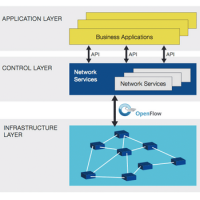Software Defined Networking vs. Network Function Virtualization

Ever wonder how the thousands and hundreds of thousands of physical and virtual nodes in the modern public cloud data center are managed? You might think that the DevOps paradigm that has revolutionized automation and administrative tools is wholly responsible, but automation is only part of the answer.
As public and private clouds becomes more ubiquitous, the increasing demand for compute and storage densities is causing a rapid paradigm shift of how data centers are architected from the ground up. Not only are the administrative tools rapidly evolving, but new hardware and networking architectures are emerging to meet the demands for abstraction of services up and down the entire cloud stack.
Two networking abstraction paradigms—Software Defined Networking (SDN) and Network Function Virtualization (NFV)—are emerging to address the need for better tools that provide the greater flexibility and more rigorous control needed to manage the thousands of separate virtual networks used in a public cloud.
SDN, first conceived in the mid-1990s as an academic exercise, has been much discussed in the past few years as one way to solve the problem. There is some debate about the best location for the controller function, but fundamentally SDN moves the control of the virtual networks out of the routers and switches into an abstract networking software layer.
Since the ratio of virtual machines to physical machines can be as few as 4:1 or as many as 5000:1 (or more), using SDN solves many networking problems that physical routers cannot. It also provides a framework for the development of network management tools, but the SDN tool set is still very much a work in progress.
NFV is an even newer standard. First proposed in September 2010 by a subgroup of the European Telecommunications Standards Institute, NFV is a conceptual framework that can be designed to manage and orchestrate not only the virtual networks but also the physical hardware, hypervisor, outside network communications, and other components in the overall architecture.
One way of thinking about NFV is to view the cloud as a set of services that need to be managed, rather than a set of physical and virtual resources. Many vendors—including HP, Cisco, and Alcatel-Lucent—are jumping on the NFV bandwagon and are actively working to create tools based on this approach.
On the surface, the two approaches appear to be somewhat at odds about how they solve the complexities of managing clouds, but SDN in many ways can be seen as a subset of the much more broadly defined NFV.
Since NFV is so new, it is hard to predict whether it will become an established standard, but it does hold the promise of being able to create a framework for developing tools that can support the needs for the telecommunications giants and the increasingly complex cloud service providers.
Are you ready to embrace NFV for your data center management?

